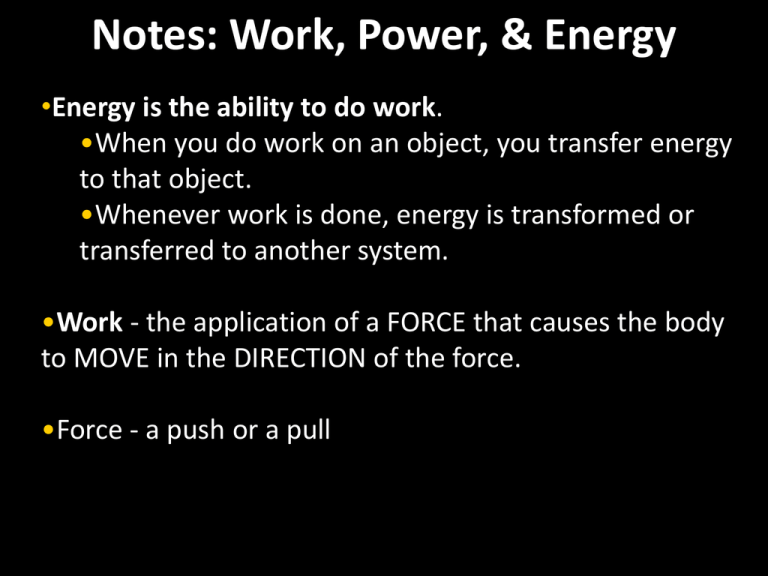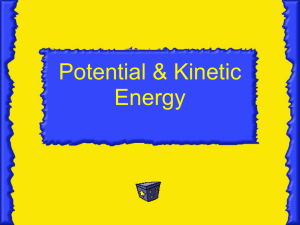Notes: Work, Power, & Energy
advertisement

Notes: Work, Power, & Energy •Energy is the ability to do work. •When you do work on an object, you transfer energy to that object. •Whenever work is done, energy is transformed or transferred to another system. •Work - the application of a FORCE that causes the body to MOVE in the DIRECTION of the force. •Force - a push or a pull • Work Equation work = force (N) distance (m) (W = F d) • Joule (J) - the scientific unit of energy (work) – = 1 kg•m2/s2 – amount of energy required to raise 1 Newton 1 meter above the Earth. • 1 Newton = .2248 lbs or 1 lb = 4.448 Newtons • 1 kg = 9.8 N – amount of energy required to raise 1 gram of water 1 degree Celsius. – Practical examples: • the energy required to lift a small apple one meter straight up. • the energy released when that same apple falls one meter to the ground. • Calories – 1 calorie = 4.184 joules – 1 dietary calorie (Calorie or Kcal) = 1000 calories – 1 dietary calorie = 4,184 joules. • Snickers = 271 Calories (kcal) – 271 kcal = 271,000 calories – 271,000 calories = 1,133,864 joules • 1,133,864 joules would raise an apple 1,133,864 meters above the Earth ( 704 miles). • 1,133,864 joules would raise an average car (3,300 pounds = 1500 kg = 15,000 Newtons) 75 meters above the Earth. • Power - the rate at which work is done or energy is transformed. • Power Equation work power time W P t • Power is measured in watts. • watt = joule per second (1 J/s). Two Main Categories of Energy Kinetic Energy Potential Energy Both are forms of Mechanical Energy • Kinetic Energy - energy of a moving object due to the object’s motion. – Kinetic energy depends on mass and velocity (speed). – Kinetic Energy Equation 1 kinetic energy = ´ mass ´ speed squared 2 1 KE = mv 2 2 • Potential Energy - “Stored Energy” - energy that an object has because of the position, shape, or condition of the object . • Gravitational potential energy - energy stored in the gravitational field which exists between any two or more objects. • GPE = mass gravity height • Elastic potential energy • Ex. spring or a rubber band. • The Law of Conservation of Energy – The law of conservation of energy states that energy cannot be created or destroyed, it can only be transformed (converted) from one form to another. • Pendulum Demonstration Pendulum Demonstration (to be continued tomorrow with bowling ball pendulum) CHECK FOR UNDERSTANDING: You give yourself and your sled gravitational potential energy as you pull your sled to the top of a snowy hill. You get on board your sled and slide to the bottom of the hill, speeding up as you go. 1. When does the sled have the most potential energy? When does it have the least potential energy? 2. Where does the sled have the most kinetic energy? the least kinetic energy? 3. What happens to the relative amounts of potential and kinetic energy as the sled slides down the hill? What happens to the total energy? 4. After the sled reaches the bottom of the hill, it coasts across level ground and eventually stops. What happened to the energy the sled had? • Forms of Energy o Heat (Thermal) energy (KE) - energy of moving particles. o Light energy (KE) o Sound energy (KE) o Electrical energy (KE) - moving charged particles. o Chemical energy (PE) - energy of bonds between atoms. o Gravitational Potential Energy (PE) o Elastic energy (PE) - Ex spring, rubber band. o Nuclear energy (PE) - Fusion in stars. Fission in reactors. o Mechanical energy (PE +KE) – An object’s kinetic and potential energies combined. • Alternative Energy – History • Coal as an alternative to wood (16th Century) • Petroleum as an alternative to whale oil (19th Century) – Renewable energy • energy generated from natural resources. • Sunlight, wind, rain, tides, geothermal heat. – Other sources? • Enthanol, wood, methane Energy Transformations • Energy readily changes from one form to another. • Potential energy can become kinetic energy. • As a car goes down a hill on a roller coaster, potential energy changes to kinetic energy. • Kinetic energy can become potential energy. • The kinetic energy a car has at the bottom of a hill can do work to carry the car up another hill. Practice Calculation: • Work: Imagine a father playing with his daughter by lifting her repeatedly in the air. How much work does he do with each lift, assuming he lifts her 2.0 m and exerts an average force of 190 N? 4 Step Method: Step 1: List variables W=? f = 190 N Step 2: Write equation/s W=f d Step 3: Plug & Chug W = 190 N 2.0 m Step 4: Answer W = 380 N-m = 380 J d = 2.0 m Practice Calculation: • Kinetic Energy: What is the kinetic energy of a 40 kg cheetah running at 30 m/s? 4 Step Method: Step 1: List variables m = 40 kg v = 30 m/s KE = ? Step 2: Write equation/s KE = 1/2 mv2 Step 3: Plug & Chug KE = 1/2 x 40 kg x (30m/s)2 Step 4: Answer KE = 18,000 kg-m2/s2 = 18,000 J Practice Calculation: • Gravitational Potential Energy A 65 kg rock climber ascends a cliff. What is the climber’s gravitational potential energy at a point 35 m above the base of the cliff? 4 Step Method: Step 1: List variables m = 65 kg GPE = ? g = 10 m/s2 h = 35 m Step 2: Write equation/s GPE = mgh Step 3: Plug & Chug GPE = 65 kg x 10m/s2 x 35 m Step 4: Answer GPE = 22,750 kg-m2/s2 = 22,750 J Practice Calculation: • Power It takes 100 kJ of work to lift an elevator 18 m. If this is done in 20 s, what is the average power of the elevator during the process? 4 Step Method: Step 1: List variables W = 100,000 Jt = 20 s d=18 m P = ? Step 2: Write equation/s P = W/t Step 3: Plug & Chug P = 100,000 Joules / 20 seconds Step 4: Answer P = 5,000 J/s = 5,000 W = 5 kW Machines and Mechanical Advantage • Machines multiply and redirect forces. • Machines help people by redistributing the work put into them. • They can change either the size or the direction of the input force. <Clicker • If you push for an hour on a stationary wall, you do no work A) on the wall B) at all C) both of these D) none of these 28 <Clicker • How much PE does the diver have at point Y? • A) 0 • B) 250 • C) 500 • D) 750 • E) 1000 29 V W X Y Z <Clicker • When an object is lifted 10 m, it gains a certain amount of potential energy. If the same object is lifted 20 m, its potential energy gain is • A) less • B) the same • C) twice as much • D) four times as much • E) more than four times as much • E • D) 30 Turn & Talk <Clicker • Which scenario below requires the most work to raise the boulder to the top of the cliff? A 31 B C A) Scenario A B) Scenario B C) Scenario C D) All are the same E) Not enough information <Clicker • An object that has kinetic energy must be • • • • • 32 A) moving B) falling C) at an elevated position D) at rest E) none of these <Clicker • At which point does the pendulum have the highest KE? • • • • • • A) 1 B) 2 C) 3 D) 4 E) 5 33 <Clicker • If you push an object twice as far while applying the same force, you do • A) twice as much work • B) four times as much work • C) the same amount of work 34 <Clicker • A job is done slowly, while an identical job is done quickly. Both jobs require the same amount of work, but different amount of • • • • 35 A) energy B) power C) both of these D) neither of these <Clicker • If you do work on an object in half the time, your power output is • A) half the usual output • B) the same output • C) twice the usual output 36 <Clicker • An object that has potential energy may have this energy because of its • • • • • A) speed B) acceleration C) momentum D) location E) none of these 37 <Clicker • A bow is drawn so that it has 40 J of potential energy. When fired, the arrow will ideally have a kinetic energy of • A) less than 40 J • B) more than 40 J • C) 40 J 38 <Clicker • When a car is braked to a stop, its kinetic energy is transformed to • • • • • 39 A) stopping energy B) potential energy C) energy of motion D) energy of rest E) heat <Clicker • Which requires more work: lifting a 50kg sack vertically 2 m or lifting a 25-kg sack vertically 4 m? • A) lifting the 50-kg sack • B) lifting the 25-kg sack • C) both require the same amount of work 40 <Clicker • A car moves 4 times as fast as another identical car. Compared to the slower car, the faster car has • • • • • 41 A) 4 times the KE B) 8 times the KE C) 12 times the KE D) 16 times the KE



